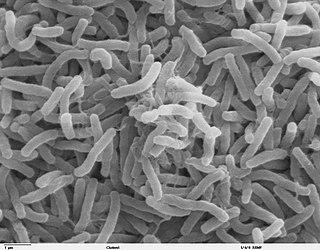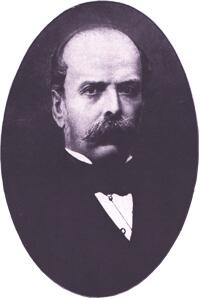
Cholera is an infection of the small intestine by some strains of the bacterium Vibrio cholerae. Symptoms may range from none, to mild, to severe. The classic symptom is large amounts of watery diarrhea that lasts a few days. Vomiting and muscle cramps may also occur. Diarrhea can be so severe that it leads within hours to severe dehydration and electrolyte imbalance. This may result in sunken eyes, cold skin, decreased skin elasticity, and wrinkling of the hands and feet. Dehydration can cause the skin to turn bluish. Symptoms start two hours to five days after exposure.

Heinrich Hermann Robert Koch was a German physician and microbiologist. As the discoverer of the specific causative agents of deadly infectious diseases including tuberculosis, cholera, and anthrax, he is regarded as one of the main founders of modern bacteriology. As such he is popularly nicknamed the father of microbiology, and as the father of medical bacteriology. His discovery of the anthrax bacterium in 1876 is considered as the birth of modern bacteriology. His discoveries directly provided proofs for the germ theory of diseases, and the scientific basis of public health.

Vibrio cholerae is a species of Gram-negative, facultative anaerobe and comma-shaped bacteria. The bacteria naturally live in brackish or saltwater where they attach themselves easily to the chitin-containing shells of crabs, shrimps, and other shellfish. Some strains of V. cholerae are pathogenic to humans and cause a deadly disease cholera, which can be derived from the consumption of undercooked or raw marine life species.
El Tor is a particular strain of the bacterium Vibrio cholerae, the causative agent of cholera. Also known as V. cholerae biotype eltor, it has been the dominant strain in the seventh global cholera pandemic. It is distinguished from the classic strain at a genetic level, although both are in the serogroup O1 and both contain Inaba, Ogawa and Hikojima serotypes. It is also distinguished from classic biotypes by the production of hemolysins.

Vibrio is a genus of Gram-negative bacteria, possessing a curved-rod (comma) shape, several species of which can cause foodborne infection, usually associated with eating undercooked seafood. Being highly salt tolerant and unable to survive in fresh water, Vibrio spp. are commonly found in various salt water environments. Vibrio spp. are facultative anaerobes that test positive for oxidase and do not form spores. All members of the genus are motile. They are able to have polar or lateral flagellum with or without sheaths. Vibrio species typically possess two chromosomes, which is unusual for bacteria. Each chromosome has a distinct and independent origin of replication, and are conserved together over time in the genus. Recent phylogenies have been constructed based on a suite of genes.
The year 1854 in science and technology involved some significant events, listed below.

Filippo Pacini was an Italian anatomist, posthumously famous for isolating the cholera bacterium Vibrio cholerae in 1854, well before Robert Koch's more widely accepted discoveries 30 years later.

Vibrio parahaemolyticus (V. parahaemolyticus) is a curved, rod-shaped, Gram-negative bacterium found in the sea and in estuaries which, when ingested, may cause gastrointestinal illness in humans. V. parahaemolyticus is oxidase positive, facultatively aerobic, and does not form spores. Like other members of the genus Vibrio, this species is motile, with a single, polar flagellum.
Exogenous bacteria are microorganisms introduced to closed biological systems from the external world. They exist in aquatic and terrestrial environments, as well as the atmosphere. Microorganisms in the external environment have existed on Earth for 3.5 billion years. Exogenous bacteria can be either benign or pathogenic. Pathogenic exogenous bacteria can enter a closed biological system and cause disease such as Cholera, which is induced by a waterborne microbe that infects the human intestine. Exogenous bacteria can be introduced into a closed ecosystem as well, and have mutualistic benefits for both the microbe and the host. A prominent example of this concept is bacterial flora, which consists of exogenous bacteria ingested and endogenously colonized during the early stages of life. Bacteria that are part of normal internal ecosystems, also known as bacterial flora, are called Endogenous Bacteria. A significant amount of prominent diseases are induced by exogenous bacteria such as gonorrhea, meningitis, tetanus, and syphilis. Pathogenic exogenous bacteria can enter a host via cutaneous transmission, inhalation, and consumption.

Aeromonas hydrophila is a heterotrophic, Gram-negative, rod-shaped bacterium mainly found in areas with a warm climate. This bacterium can be found in fresh or brackish water. It can survive in aerobic and anaerobic environments, and can digest materials such as gelatin and hemoglobin. A. hydrophila was isolated from humans and animals in the 1950s. It is the best known of the species of Aeromonas. It is resistant to most common antibiotics and cold temperatures and is oxidase- and indole-positive. Aeromonas hydrophila also has a symbiotic relationship as gut flora inside of certain leeches, such as Hirudo medicinalis.
The discovery of disease-causing pathogens is an important activity in the field of medical science. Many viruses, bacteria, protozoa, fungi, helminthes and prions are identified as a confirmed or potential pathogen. In the United States, a Centers for Disease Control program, begun in 1995, identified over a hundred patients with life-threatening illnesses that were considered to be of an infectious cause, but that could not be linked to a known pathogen. The association of pathogens with disease can be a complex and controversial process, in some cases requiring decades or even centuries to achieve.
Vibriocins are a group of bacteriocins produced by, and active against, gram-negative bacteria in the genus Vibrio. They were first discovered in 1962, considerably after the original bacteriocins, the colicins, which were discovered in 1925.

Monera (/məˈnɪərə/) is a biological kingdom that is made up of prokaryotes. As such, it is composed of single-celled organisms that lack a nucleus.

Sambhunath De ; was an Indian medical scientist and researcher, who discovered the cholera toxin, the animal model of cholera, and successfully demonstrated the method of transmission of cholera pathogen Vibrio cholerae.

Diseases and epidemics of the 19th century included long-standing epidemic threats such as smallpox, typhus, yellow fever, and scarlet fever. In addition, cholera emerged as an epidemic threat and spread worldwide in six pandemics in the nineteenth century. The third plague pandemic emerged in China in the mid-nineteenth century and spread worldwide in the 1890s.

Vampirovibrio chlorellavorus is a 0.6 µm pleomorphic cocci with a gram negative cell wall, and is one of the few known predatory bacteria. Unlike many bacteria, Vampirovibrio chlorellavorus is an obligate parasite, attaching to the cell wall of green algae of the genus Chlorella. Vampirovibrio originates from the Serbian vampir. meaning vampire and vibrio referring to the bacterial genus of curved rod bacterium. Chlorellavorus is named for the algal host of the bacterium (Chlorella) and the Latin voro meaning "to devour" (Chlorella-devouring).
John Mekalanos is a microbiologist who is primarily known for leading one of the first teams that reported the discovery of the type VI secretion system as well as his work on the pathogenicity of the bacterial species Vibrio cholerae, its toxin, and its secretion systems. Since 1998, he has been a member of the National Academy of Sciences.

Melanie Blokesch is a German microbiologist. Her research focuses on Vibrio cholerae, the bacterium causing cholera. She is a professor of life sciences at École Polytechnique Fédérale de Lausanne (EPFL), where she heads the Laboratory of Molecular Microbiology.
Secondary chromosomes are a class of bacterial replicons. These replicons are called "chromids" because they have characteristic features of both chromosomes and plasmids. Early on, it was thought that all core genes could be found on the main chromosome of the bacteria. However, in 1989 a replicon was discovered containing core genes outside of the main chromosome. These core genes make the chromid indispensable to the organism. Chromids are large replicons, although not as large as the main chromosome. However, chromids are almost always larger than a plasmid. Chromids also share many genomic signatures of the chromosome, including their G + C content and their codon usage bias. On the other hand, chromids do not share the replication systems of chromosomes. Instead, they use the replication system of plasmids. Chromids are present in 10% of bacteria.












